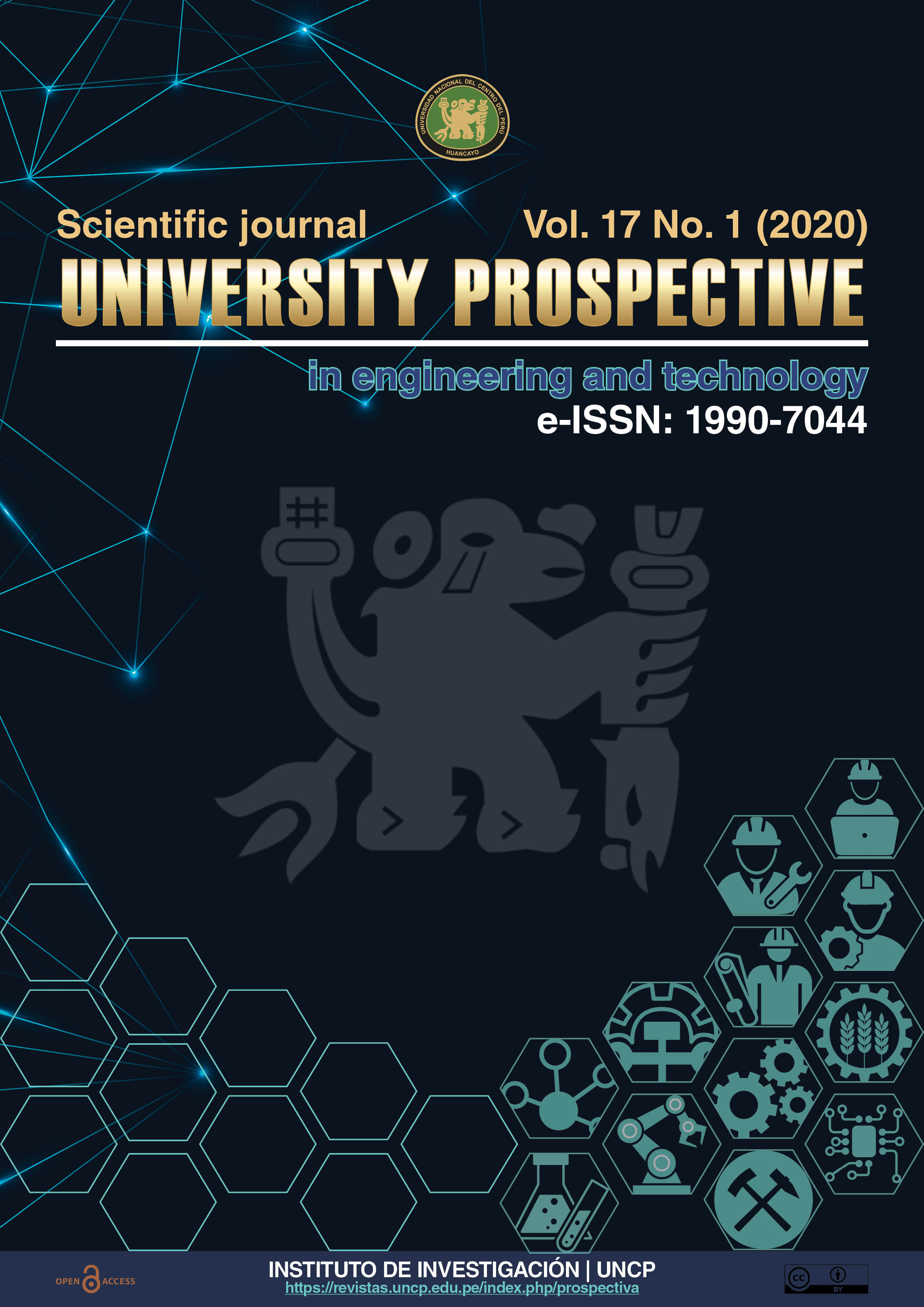Workability of concrete with bagged mixtures and its influence on strength
DOI:
https://doi.org/10.26490/uncp.prospectivauniversitaria.2020.17.1386Keywords:
Bagging mix, Workability, Compressive strength, Ready-mixed, Construction technologyAbstract
New technologies allowing to increase the construction speed and durability of concrete appear every day and the difficulties of their use are greater, hence the need to resort to a concrete capable to be dry prepared. Preliminary researchs certify advantages over conventional concrete in adverse situations such as remoteness and shortage of aggregates.
In this research, in order to improve the properties of UNICON and TOPEX bagged concrete, the amount of water per bag of concrete has been varied in order to obtain adequate workability without impairing compressive strengthh. The obtained information can be used to increase productivity in building construction.
The research was experimental, 4” and 8” witnesses were prepared to determine the resistance to compression (3, 7 and 28 days) and workability through its consistency; for this, different doses of water were used: 3.5, 4.0, 4.5, 5.0 and 5.5 l/bag. A concrete resistance 210 kg/cm2 was obtained for 28 days with 4.99 l/bag and settlement 7.19” for UNICON and with 4.41 l/bag and settlement 7.15” for TOPEX; a concrete resistance 175 kg/cm2 with 5.25 l/bag and settlement 7.6 "for UNICON and with 4.85 l/bag and settlement 8.1" for TOPEX; a concrete resistance 140 kg/cm2 with 5.55 l/bag and 8” settlement for UNICON and with 5.2 l/bag and 8.3” settlement for TOPEX. It is concluded that, the greater the amount of water, the greater the workability, the slight segregation and the lower resistance to compression.
Downloads
References
Arana, M. & Chinchayán, C. (2012). Estudio de prefactibilidad para la implementación de una planta procesadora y comercializadora de concreto seco embolsado para la empresa DINO S.R.L. Universidad Privada del Norte, Trujillo.
ASTM C127 (2001). Standard Test Method for Density, Relative Density (Specific Gravity), and Absorption of Coarse Aggregate.
ASTM C128 (2003). Standard Test Method for Density, Relative Density (Specific Gravity), and Absorption of Fine Aggregate.
ASTM C136 (2001). Standard test method for sieve analysis of fine and coarse aggregates.
ASTM C143 (2000). Standard test method for slump of hydraulic-cement concrete.
ASTM C143M (2003). Standard test method for slump of hydraulic-cement concrete.
ASTM C29/C29M (2003). Standard test method for bulk density (“Unit Weight”) and voids in aggregate.
ASTM C33 (2003). Standard specification for concrete aggregates.
ASTM C39M (2003). Standard test method for compressive strength of cylindrical concrete specimens1.
Flores, L. (2017). Evaluación de la calidad fisicoquímica y microbiológica del agua potable para consumo humano en los distritos de El Tambo, Huancayo y Chilca en el año 2014. UNCP, Huancayo.
Galarza, M. (2011). Desperdicio de materiales en obras de construcción civil: métodos de medición y control. Pontificia universidad católica del Perú, Lima.
Guevara, G.; Hidalgo, C.; Pizarro, M.; Rodríguez, I.; Rojas, L. & Segura, G. (2011). Efecto de la variación agua/cemento en el concreto. Revista Tecnología en Marcha. Vol. 25, Nº 2, Costa Rica.
Morillas, M. & Plasencia, D. (2018). Características mecánicas de un concreto premezclado en seco “concreto rápido” f’c = 210 kg/cm2 y su costo comparativo. Universidad Privada Antenor Orrego, Trujillo.
Nishihara, J. (2013). Mezclas secas pre-dosificadas para preparación de concretos estructurales. Obtenido de http://continental.edu.pe/emprendimiento/wp-content/uploads/2013/08/proyecto23_concreto_estructural.pdf
NTP 339.034. (2008). Concreto: Método de ensayo normalizado para la determinación de la resistencia a la compresión del concreto, en muestras cilíndricas. INDECOPI, Lima.
NTP 339.035. (2009). Concreto: Método de ensayo para la medición del asentamiento del concreto de cemento Portland. INDECOPI, Lima.
NTP 339.088. (2006). Concreto: Agua de mezcla utilizada en la producción de concreto de cemento Portland. Requisitos. INDECOPI, Lima.
NTP 339.114. (2012). Concreto: Concreto premezclado. INDECOPI, Lima.
NTP 400.012. (2013). Agregados: Análisis granulométrico del agregado fino, grueso y global. INACAL, Lima.
NTP 400.017. (2011). Agregados: Método de ensayo normalizado para determinar la masa por unidad de volumen o densidad ("Peso Unitario") y los vacíos en los agregados. INDECOPI, Lima.
NTP 400.021. (2002). Agregados: Método de ensayo normalizado para peso específico y absorción del agregado grueso. INDECOPI, Lima.
NTP 400.022. (2013). Agregados: Método de ensayo normalizado para la densidad, la densidad relativa (peso específico) y absorción del agregado fino. INDECOPI, Lima.
NTP 400.037. (2014). Agregados: Especificaciones normalizadas para agregados en concreto. INDECOPI, Lima.
Pasquel, E. (1993). Tópicos de tecnología de concreto en el Perú. Colegio de Ingenieros del Perú, Lima.
Rivva, E. (2000). Naturaleza y materiales del concreto.Capitulo peruano ACI, Lima.
Rojas, K. (2010). Análisis comparativo del comportamiento del concreto seco en condiciones producidas y recomendadas. Universidad Nacional de Ingeniería, Lima.
Sabino, C. (2002). El proceso de investigación. Panapo, Venezuela.
Downloads
Published
Issue
Section
License
Copyright (c) 2020 Richard Hugo Reymundo Gamarra

This work is licensed under a Creative Commons Attribution-NonCommercial-ShareAlike 4.0 International License.
Esta Revista es de acceso abierto a su contenido a través del Internet, poniendo a disposición de la comunidad científica los resultados de la investigación, de manera gratuita, para el intercambio del conocimiento desarrollado.
El contenidos de la Revista se distribuyen bajo la licencia Creative Commons Reconocimiento-NoComercial-CompartirIgual 4.0 Internacional.
![IconJournalPU [ENG] by Edgar Julian-Laime®](https://revistas.uncp.edu.pe/public/journals/1/pageHeaderLogoImage_en.png)









